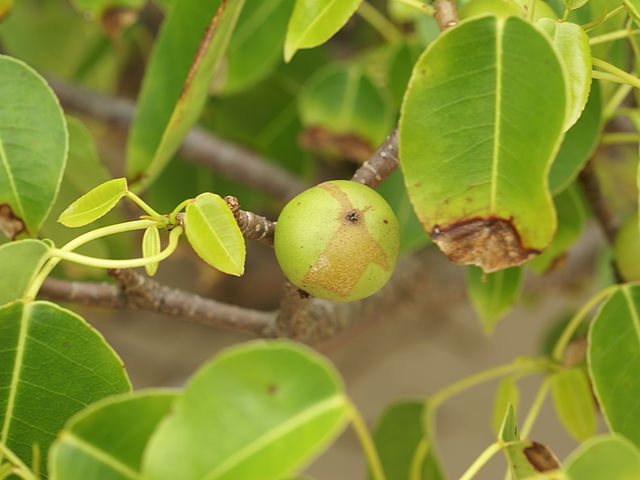Bad Apple

The apple pictured above may look familiar. The fruit resembles the Granny Smith cultivar and the leaves and branches are not obviously different than that of an apple tree. But that is not an apple — and you do not want to eat it. It’s the fruit of the manchineel tree, and it is one of the most poisonous trees out there.
The manchineel tree is native to the Western Hemisphere, appearing as far north as Florida and present into the Caribbean, Central American, and South American. In many places, people mark the trees with a red band or red X to warn passersby of its danger. The danger is real — and easily encountered. Eating the fruit will almost certainly require hospitalization, but not consuming the “apple” is not enough to avoid harm. The tree’s sap is incredibly poisonous — and seemingly instantaneously so. The milky white sap causes the skin to blister if even a drop gets on you, which happens to unsuspecting travelers who make the enormous mistake of using a manchineel tree as shelter from a rain storm. The bark is also poisonous; burning it yields smoke which, apparently, causes temporary (and perhaps permanent) blindness. In fact, the fruit may be the least poisonous feature of the tree; while legend has it that the “apple” is fatal, there are no known deaths from eating one.
There is, however, a rather famous death cause by manchineel poison, that of Juan Ponce de Leon. In 1521, the Spanish conquistador returned to Florida in search of gold and to lay claim to the area he discovered. (The stories of him searching for the Fountain of Youth post-date his life and are almost certainly improperly ascribed to him.) But of course, his discovery was of land already inhabited by natives, and only new to those hailing from Europe. The Calusa, who called part of Florida home, took to arms against Ponce de Leon firing arrows at him. One arrow in particular lodged into Ponce de Leon’s leg; that arrow, it is now believed, was dipped in sap from a manchineel tree. Ponce de Leon died before the end of that same summer, most likely from complications from the manchineel’s poison.
Bonus fact: Granny Smith apples were first cultivated in Australia in 1867 but took over fifty years to make it to the United Kingdom. By comparison’s sake, though, that’s quick — Granny Smiths first were imported into the United States in 1972, a century after their discovery.
From the Archives: Miracle Berries: Safe to eat, but will wreak havoc on your taste buds.
Related: Ponce de Leon never found the Fountain of Youth, but you can build one yourself. (Caution: may not actually provide youth, and may also contain choking hazards for the actual youths in your lives.)
